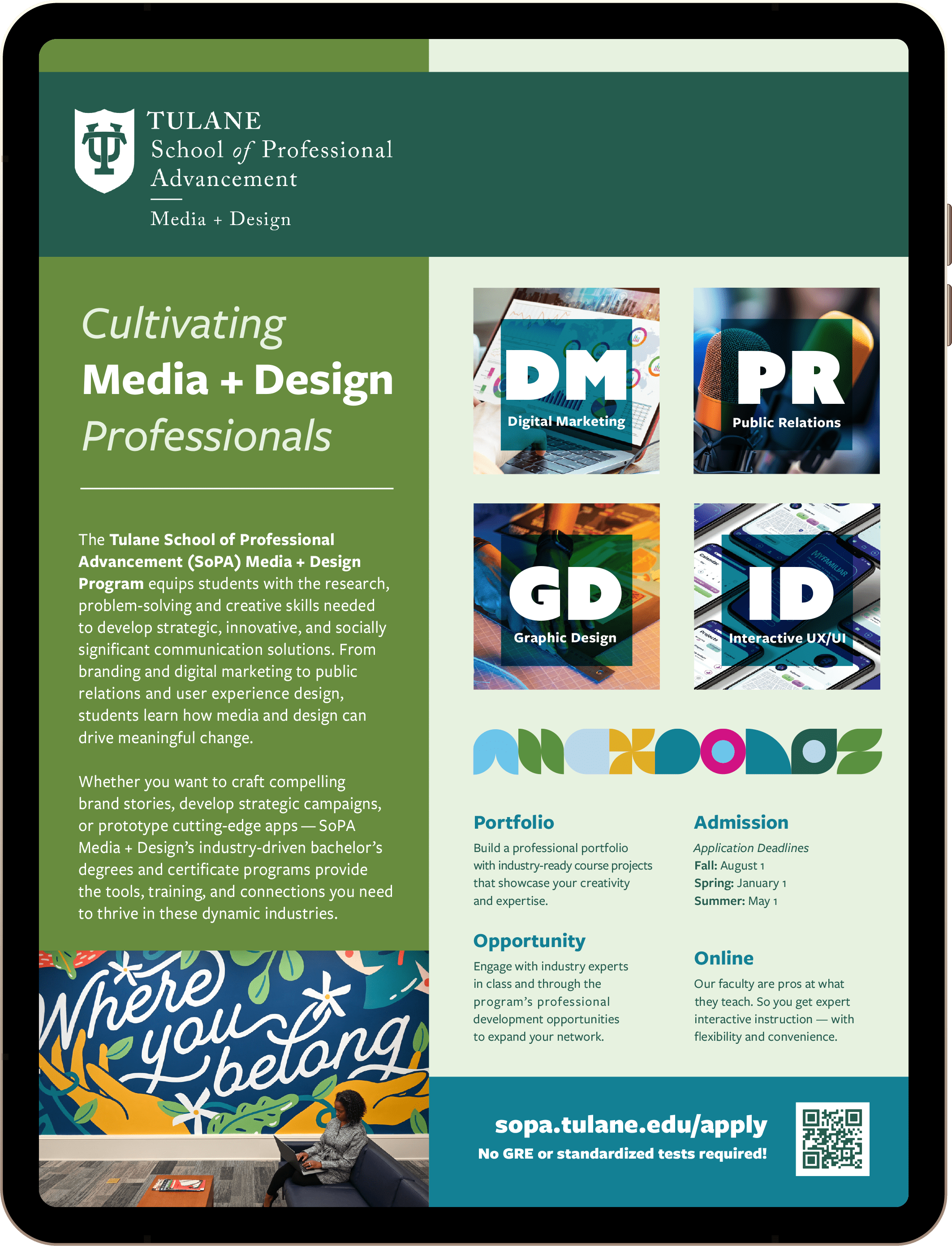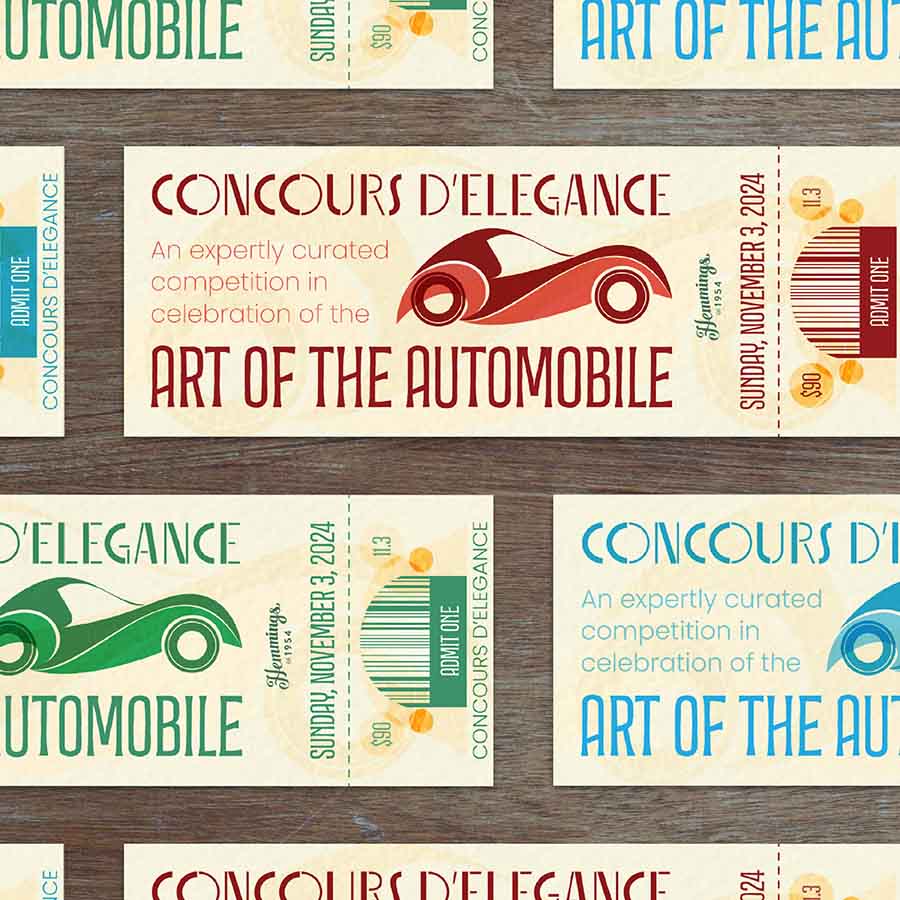Online Bachelor of Arts in Digital Design: Graphic Design
Request Information
By submitting this form, you agree to receive information about the Tulane School of Professional Advancement’s programs via email, phone and/or text. You may opt out at any time.
Graphic Design Bachelor's Degree at a Glance
Want to create visually compelling designs that inform, delight, and inspire? Want to learn the principles of typography, color theory, and composition — then apply them to branding, packaging, and interactive media?
This 120-credit online bachelor’s degree program is ideal for aspiring graphic designers and professionals looking to enhance their skills in visual communication. You’ll gain proficiency with tools like Adobe Creative Cloud while mastering design fundamentals that will set you apart professionally

Affordable
Tuition

Online
Courses

Expert
Faculty

No Test
Scores

Rolling
Admission

Multiple
Start Dates


Careers in Graphic Design
The need for graphic designers is expected to grow steadily over the next several years. Whether you’re looking to join an agency or design firm, work in-house for a brand you love, or start your own freelance business, graphic designers are highly marketable in almost any field. Sample careers include:
- Graphic designer
- Graphic artist
- Environmental designer
- Front-end web designer
- Infographic designer
- Packaging designer
- Print/publication designer
- Social media content designer
- Art director
- Creative director
What You'll Learn While Earning Your Degree in Graphic Design
This bachelor’s degree gives you a solid foundation in the theory and practice of visual communication and graphic arts. You’ll master key design principles like color theory, typography, and composition, which are essential for creating impactful and visually appealing work. You’ll also explore branding and identity design, learning how to craft cohesive visual identities for businesses.
With hands-on training in tools like Adobe Creative Cloud, you’ll gain the skills to produce professional-grade designs. The program covers everything from layout and print design (ads, posters, brochures, magazines) to digital media (motion graphics, web, and app design). Courses in interactive and UX/UI design will teach you how to create intuitive, engaging digital experiences.
Throughout, you’ll build critical thinking and problem-solving skills through design thinking, preparing you to tackle real-world challenges with creativity and confidence.
- Digital Design Foundations
- Typography Studio
- History of Graphic Design
- Branding & Semiotics
- Motion Design
- Capstone: Media + Design
See the Tulane University course catalog for a complete list of required courses for the BA in Digital Design: Graphic Design Track. You can also download this sample matriculation guide, which includes a list of suggested electives.
The Tulane School of Professional Advancement awards the B.A. in Digital Design: Graphic Design following the completion of 120 credits, which includes 42 credits in the major. An 18-credit Graphic Design minor is also available as is a 30-credit Graphic Design post-baccalaureate certificate (PBC) for those who already have a bachelor’s degree.
All students in the Digital Design major take core courses in design foundations and then declare a career track to specialize in either Graphic Design or Interactive UX/UI Design.
The degree can be earned entirely online, with in-person options for some electives and courses in the core curriculum. And because you may transfer up to 60 credits towards the 120-credit requirement, you could earn your degree in two to four years.
Explore SoPA’s Media + Design Program
From digital marketing campaigns to motion graphics to cutting-edge app prototypes, the Media + Design program prepares students to use public relations, digital marketing, graphic design, and interactive design to shape the world around us.
Take a look at all 12 of our applied degree, certificate, and minor offerings. See the work our students and alumni are creating. And find out how everything fits within the larger picture.
Expert Faculty to Guide Your Path

Our diverse faculty is comprised of award-winning industry professionals and subject-matter experts working in the fields of advertising, digital marketing, graphic design, interactive design, influencer strategy, corporate communication, and public relations. They guide you through an accredited, industry-driven curriculum developed to give you the expertise and skills most in demand today.

Meet the Director
“In a society where media is so pervasive and ever-changing, I think it's vital; for students to learn the problem-solving skills necessary to create strategic, innovative, cultural, and socially significant communications solutions.”
Tamar Gregorian, PhD
Program Director
Senior Professor of Practice

Media + Design Student Spotlight
“My educational experience until now was that everything taught in school was theoretical. With this program, everything is very hands-on. I saw that there was a practical application for what I was working on, and I was able to be very engaged with that.”
Raul Fuster
Tulane SoPA class of 2025
An Engaging & Flexible Online Learning Experience
Connect with motivated classmates and experienced professionals in an environment that nurtures creativity and collaboration
Year after year, our students earn local and national recognition for their exceptional work. Take a look—and get inspired!
Navigate degree requirements and prepare for the workforce with personalized help from our academic advisors and dedicated career counselor.
Meet our advisory board, the media and design leaders who inform our coursework based on current needs and trends.
Quick Facts
Tulane SoPA accepts students on a rolling basis, year-round. Start dates every August, January, May, and June. We never require test scores or recommendations. Visit our Admissions Process page to learn more.
All tuition is charged by the credit hour and we have minimal fees. Visit our tuition page to see our current tuition rates and use our net price calculator.
We strive to make a Tulane SoPA education affordable for all students. Learn about financial aid, discounts and scholarship opportunities here.
You may transfer up to 60 credits to our undergraduate programs. Review admissions information for applying as a transfer student.
SoPA offers credit for your prior work experience through an assessment of your work portfolio. Undergraduates can earn up to 24 credits.


Enter your email to download our Media + Design e-brochure.
By submitting this form, you agree to receive information about the Tulane School of Professional Advancement’s programs via email, phone and/or text. You may opt out at any time.









